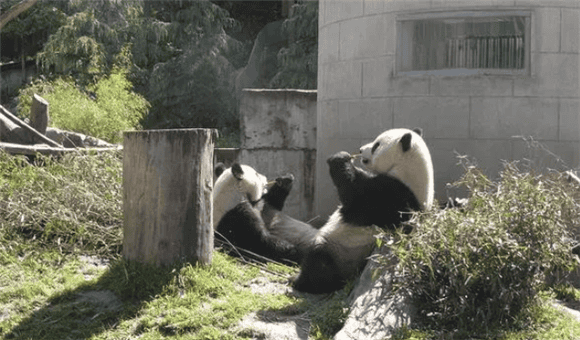As we all know, the giant panda is a unique species in my country and one of the national treasures. It is loved by people all over the world for its black and white fur and innocent appearance. At the same time, giant pandas are also friendly envoys of my country's foreign exchanges and have made significant contributions to promoting friendly exchanges between China and foreign countries. So how do giant pandas promote international friendly exchanges? The captain will tell you in detail.

One, Characteristics of the Giant Panda
Giant Panda
The giant panda is a terrestrial mammal. It is the only species of the genus Giant Panda in the order Ursidae and is divided into Qinling Giant Panda and Sichuan Giant Panda. There are two subspecies of pandas, mainly distributed in the Qinling Mountains and the Sichuan Basin. There are more than 2,000 pandas in existence. They are endemic to China. In recent years, due to the tremendous efforts of my country and international environmental protection organizations, the survival status of giant pandas has been downgraded from "endangered" to "vulnerable".
Shi Panda
The ancestor of the giant panda is Shi Panda, which lived at the end of the Miocene about 8 million years ago. Its fossils are distributed in the tropics in Lufeng and Yuanmou, Yunnan. Moist forest. The panda was a carnivore, and later evolved into an omnivore over millions of years of evolution, and its distribution range also continued to change. Although giant pandas are omnivores, their diet is not much different from that of herbivores. They mainly feed on bamboo, and occasionally eat insects, bamboo rats and other meaty foods.
Tuantuan, Yuanyuan
Although giant pandas in the zoo live in pairs, giant pandas in the wild are solitary animals. In addition to reproducing offspring during estrus, they usually Pandas live alone and have their own activity areas. This has a lot to do with the eating habits of giant pandas. Because the "T1R1" gene in their bodies is inactivated, they cannot feel the delicious taste of meat and can only feed on plants such as bamboo. However, bamboo leaves are low in calories, so giant pandas have to spend a lot of time eating every day. In order to save heat, giant pandas maintain a static life and avoid interacting with similar animals.
Jia Jia
Female giant pandas give birth to 1-2 cubs per litter, weighing 85-142 grams, but the mother usually only raises the stronger cub. And abandoned the thin cub. The cubs usually stay with their mother for 1 and a half to 2 years before leaving to live on their own. The giant pandas raised artificially have good living conditions, and both giant panda cubs will receive good care.
The lifespan of a giant panda is generally 15-20 years (a giant panda's one-year lifespan is approximately equivalent to a human's three-year lifespan), but the lifespan of artificially raised giant pandas can be as long as more than 30 years. The oldest known giant panda is Jia Jia, a female giant panda who was once raised in Hong Kong's Ocean Park. She lived to be 38 years old when she died.

Second, The giant panda is well known
The Lin family's national treasure is as big as a tiger, with colorful features and a tail longer than the body. It is named Zuowu and can travel thousands of miles on it. The Book of Mountains and Seas·Hai Nei Bei Jing No. 12
I was about to accept the Northern Kingdom because of my uncle. Real gains are real plunder, real acres are real borrowings. Offer his brave skin, which is red leopard and yellow. (The Book of Songs·Daya)
Armand David
Although giant pandas have lived in China for millions of years, they have been studied and protected for more than a hundred years. Something to come. The "Zouwu" in the ancient pre-Qin book "The Classic of Mountains and Seas" and the "Pixiu" in the "Book of Songs" may be the ancient names of giant pandas. Because the records and illustrations in ancient literature are too simple and random, there is still no strong evidence that the animals or prototypes referred to by names such as "Zouwu" and "Pixiu" are giant pandas. It is only speculation and there is a lack of empirical evidence.
In 1869, French Catholic missionary Armand David found a giant panda skin in a villager's house in Baoxing County, Sichuan. He thought it was a new species and named it "Ursus". melanoleucus” (black and white bear). Armand David then made a giant panda specimen and sent it to the French National Museum of Natural History in Europe. Zoologist Alphonse Miller Edwards immediately studied the giant panda specimen, confirmed it as a new species, and published Research Papers. Since then, giant pandas have gradually become more widely known, and humans have begun to study them.
Ruth Elizabeth Harkness
In 1916, Hugo Weigood, a member of the German Stotzner expedition, bought a giant panda cub in the Kangding area. Became the first person in the West to see a living giant panda. Since then, "panda fever" has emerged in European and American countries, and many explorers have formed expedition teams to search for giant pandas in China. In 1936, American explorer Ruth Elizabeth Harkness successfully brought a living giant panda to the United States and named it "Su Lin", making Su Lin the first giant panda to leave her homeland.
3. Diplomacy and Protection
The Anti-Japanese War
In 1938, the New York Zoological Society submitted a request for cooperation to West China Union University, hoping to provide scientific instruments and books Waiting for aid in exchange for giant panda cubs. Then Ding Kesheng, a foreign biology professor at West China Union University, and his wife purchased a giant panda cub from a local hunter, named it "Pandora" and shipped it to the United States.
In March 1941, American non-governmental organizations launched a fundraising campaign to support China in resisting Japanese slaves. Soon Pandora died of illness, and the American people were grieved. Later, in order to thank the donations from private organizations officially supported by the United States, China presented the giant pandas "Panda" and "Pandi" to the United States, which became the earliest beginning of "panda diplomacy."
World Wildlife Fund
In 1961, the World Wildlife Fund (the predecessor of WWF) was established in order to find a way to cross human language and cultural barriers and be easily identifiable As a symbol that can easily create a strong impression on people, the lively and cute giant panda was successfully selected. The World Wildlife Fund then designed a logo based on the giant panda "Ji Ji". Director Peter Scott explained, "We chose it (the giant panda) because it is a beautiful and lovely endangered species. , it has attractive qualities and is loved by many people in the world."
President Nixon
In 1972, U.S. President Richard Milhouse Nixon and his wife. Thelma Catherine "Pat" Ryan Nixon's visit to China greatly improved Sino-US relations and promoted friendly exchanges between the two sides. China then donated giant pandas "Ling Ling" and "Xing Xing" to the United States, which became the most famous panda diplomacy in history.
Sichuan Basin
In 1982, in order to protect the endangered giant pandas, China stopped donating giant pandas to the outside world and instead leased giant pandas at a rent of US$1 million per year. Panda breeding and scientific research. At present, China has a number of research institutions and reserves such as the "China Giant Panda Conservation and Research Center" and the "Wolong National Nature Reserve", which have made great contributions to promoting the protection and reproduction of giant pandas.
In general, the giant panda is our country’s national treasure, deeply loved by people all over the world, and has made a significant contribution to friendly exchanges between China and foreign countries.

 扫一扫微信交流
扫一扫微信交流
发布评论